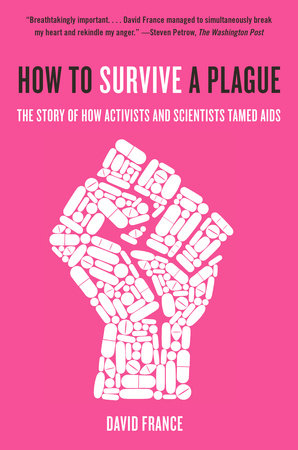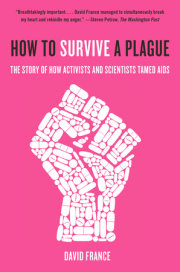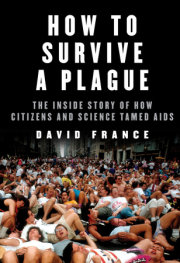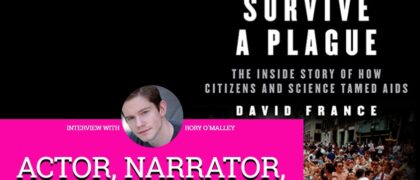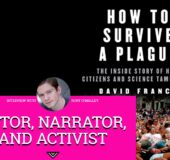I didn´t have serious concerns for my own health. What I worried about was Brian Gougeon. I checked on him frequently. Neither of us brought up AIDS directly or his health specifically, though I sensed he resented my calls as reminders of that scare. Like characters in a Saramago novel, we talked about anything else. The news was generally good. He resumed the physically taxing work of tending the vast vertical jungle of ficus trees and philodendron bushes that filled high-rises throughout the city. He confided that the East Village gallery scene had been cool to his work, but reported the good news that he was back with his college boyfriend, and had never been happier.
I don’t want to overstate our sense of impending doom. The truth was, the storm clouds massed near the horizon, not overhead. Unless you were personally admitted into what Susan Sontag called “the kingdom of the sick,” it was not hard to put the growing epidemic out of mind. It took two years and almost six hundred dead before
The New York Times put a story on the front page. Except in passing, few television news programs made any mention. The progressive
Village Voice ran a feature that called the danger overblown, and was nearly silent otherwise. You would have to read the
Native for news on AIDS.
Brian Gougeon avoided the newspapers. I know he saw the first major report in prime time, since we watched it together on my small black-and-white TV. The ABC newsman Geraldo Rivera, flamboyant and hyperbolic though he was, broke the near-complete media blackout with the first network broadcast.
“It is the most frightening medical mystery of our time,” Rivera said, leaning toward the camera. “There is an epidemic loose in the land, a so-far incurable disease which kills its victims in stages.”
And then appeared the face of a man in grotesque medical distress— the first plague-sickened man either Brian or I had laid eyes on. He was a freelance lighting designer named Ken Ramsauer, age twenty-seven. In an old photograph, he looked as polished and angular as a shampoo model. The difference between then and now was shocking. His head appeared swollen nearly to the brink of popping; his eyes vanished behind swollen muffins of flesh; oblong purple marks covered his skin. Confined to a wheelchair, he hung his head weakly. A friend handed him a glass of water, which was almost too heavy for his trembling arms. “I thought I was a pretty good-looking guy,” he said. “And now, I actually see myself fading away.”
Ramsauer said he had just returned from the hospital, where they offered him neither medicine nor hope, and least of all pity. “One night I heard two, I believe, nurse’s aides—not the actual nurses—standing outside my door sort of laughing,” he said.
“What did they say exactly?” Rivera asked.
He blinked his slivered eyes and looked down at the water glass in his scarlet fists, remembering: “I wonder how long the faggot in 208 is going to last.”
Four days later, I opened the paper to discover that Ramsauer was dead. When I read that a public memorial was planned at the Naumburg Bandshell in Central Park, I asked Brian to go with me. But he was taking a different strategy. “I’m just staying out of the whole thing,” he said, meaning AIDS. “Worrying isn’t good for your health. And it does nasty things to your art.”
Instead I went with another friend, a graphic designer named Ian Horst. That evening was unusually still and hot. As we approached the service from the south, beneath a vaulted canopy of American elms and a row of towering statuary, a macabre scene confronted us. The plaza was crowded with 1,500 mourners cupping candles against the darkening sky. As our eyes landed on one young man after another, it became obvious that many of them were seriously ill. A dozen men were in wheelchairs, so wasted they looked like caricatures of starvation. I watched one young man twist in pain that was caused, apparently, by the barest gusts of wind around us. In New York there were just 722 cases reported, half the nation’s total. It seemed they were all at the band shell that sweltering evening.
My friend’s mouth hung open. “It looks like a horror flick,” he said.
I was speechless. We had found the plague.
From there, it was an avalanche. A Friday or two later, a colleague from work ran out the door for a weekend of social commitments. He looked as healthy as a soap opera star, which he aspired to be. We never saw him again. I heard from a mutual friend that he was found dead by neighbors the following week, shrunken and hollow, in a room washed in his own feces. In whispers, we wondered if he had taken his own life—and debated whether it would be more stoic to face the disease or commit suicide.
As the summer of 1983 opened,
The New York Times finally started covering the plague, but often in bizarre ways. In May, the paper revealed that prisoners on Rikers Island had declared a hunger strike, unwilling to risk using plates or utensils after an inmate dropped dead from AIDS, and a week later reported on a sanitation worker who might have caught AIDS from handling trash. Readers were left more frightened than ever. We read reports of parents who would not go near their infected sons, not even to bid farewell. Many hospital workers felt the same way, abandoning AIDS-sick patients in diarrhea-soaked sheets out of fear and prejudice. Dr. Robert Gallo, head of the Laboratory of Tumor and Cell Biology at the National Cancer Institute, a branch of the National Institutes of Health, was disgusted when he first heard the sick joke that pancakes were the only food fit for an AIDS patient, because they could fit under the door. In this environment, even doctors felt justified to exempt AIDS sufferers from the Hippocratic Oath—in one survey, over half admitted they would refuse them medical attention if given a choice.
The patients’ indignities did not end with death. Across New York, the global epicenter of this outbreak, almost every undertaker refused to work with the corpses. Even in the ancient plagues of Europe there were individuals tasked with collecting remains. In The Betrothed, the novelist Alessandro Manzoni called them monatti, those unflappable Samaritans who, for profit or otherwise, braved the “rags and corrupted bandages, infected straw, or clothes, or sheets” to convey the lifeless flesh to the ditches. In New York at the dawn of AIDS, only Redden’s Funeral Home, operating continuously since the Spanish influenza epidemic of 1918–19, would handle the embalming. Yet its owners begged the grateful mourners to keep their kindnesses a secret for fear of boycotts by the aging Catholic community in Greenwich Village and Chelsea, the bulk of their business.
Copyright © 2016 by David France. All rights reserved. No part of this excerpt may be reproduced or reprinted without permission in writing from the publisher.

